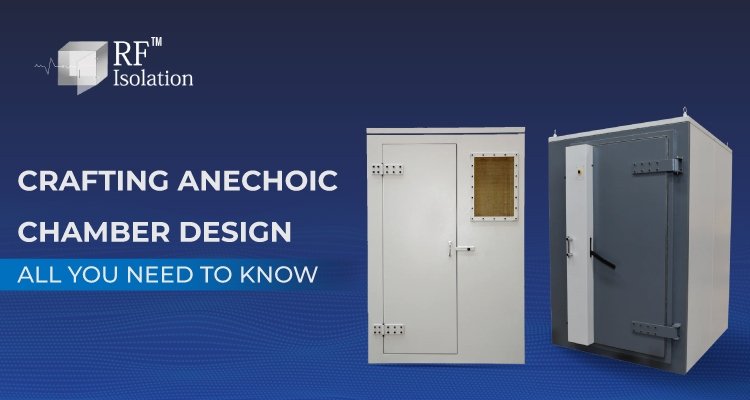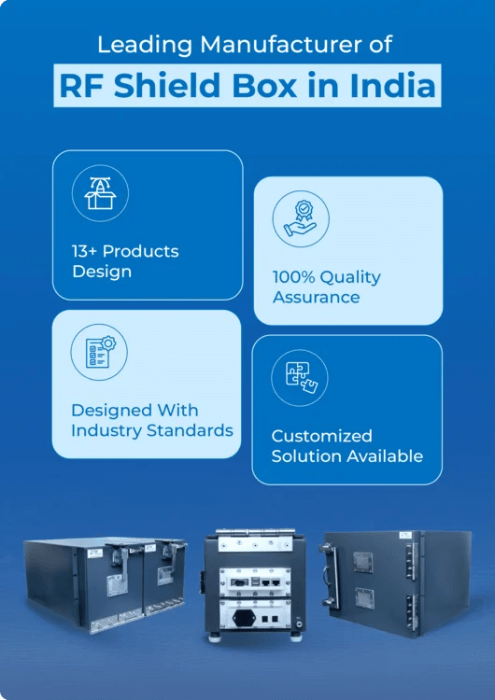
Crafting Anechoic Chamber Design: All You Need to Know
Introduction
Electronic equipment, wireless devices, and communication systems generate a variety of electromagnetic waves that can impact nearby devices and vice versa.
To avoid electromagnetic interference in the product design and development stages of various devices, manufacturers demand a silent and special room that doesn’t get affected by electromagnetic waves coming from the surrounding environment.
Here, Anechoic Chambers stands as a cornerstone in establishing controlled testing environments for accurate measurements. Anechoic chambers provide precise and reliable testing environments to allow device testing with high reliability and efficiency.
In this blog, we will explore deeply about Anechoic chambers including their uses, advantages, and design considerations.
What is an anechoic chamber?
What are the different types of anechoic chambers?
Anechoic chambers are available in the following types:
1. Acoustic Chambers
2. Rf Shielded Rooms
3. Full Anechoic Chambers
4. Semi-anechoic Chambers
What is the working principle of an anechoic chamber?
An anechoic chamber is a room designed to completely absorb reflections of either sound or electromagnetic waves.
It works effectively due to its unique absorptive lining. The absorptive lining is designed to absorb electromagnetic waves and prevent them from reflecting back into the room.
The working principle of an anechoic chamber is based on the use of these absorptive linings, special materials, and geometric shapes to minimize the reflection of waves within the chamber.
Through the use of sound-absorbing or RF-absorbing materials on the walls, floor, and ceiling of the chamber, anechoic chambers provide a safe and interference-free environment for testing.
What are the uses of an anechoic chamber?
The uses of anechoic chambers are diverse.
Acoustic anechoic chambers are utilized for testing and calibrating audio equipment, conducting acoustic research, and testing the sound quality of products such as speakers, microphones, and other audio devices.
On the other hand, electromagnetic anechoic chambers are used for testing antennas, wireless devices, and electromagnetic compatibility (EMC) testing.
What are the design considerations of an anechoic chamber?
Design of Anechoic Chamber:
An anechoic chamber is a room-sized enclosure made of metal. It has radio wave absorbers covering the walls and ceiling and sometimes includes the floor. These absorbers are designed to absorb waves.
Design Considerations for Anechoic Chamber:
There are certain design considerations that need to be considered to ensure anechoic chambers function as required. Below are the considerations:
Size of the chamber:
The size of an anechoic chamber is one of the crucial factors in its design. To ensure it performs effectively, select the right chamber size and follow the necessary guidelines for minimum dimensions.v
Consider the type of device under test, frequency, required measurement distance, wedge depth, and wall thickness when choosing the chamber.
Structure and material selection:
The material selected for the construction of the walls, floor, and ceiling should have proper transmission loss. Furthermore, the anechoic chamber structure should be designed considering the outside noise levels and noise levels expected from the device under test (DUT).
Wedges requirements:
Adding wedges inside the anechoic chamber can enormously increase the noise reduction value; hence, the floors and ceiling need to be covered with wedges. This will allow minimum reflections and interferences inside the chamber.
Moreover, select the right materials for wedges. Consider using wedges made of foam, perforated metal, and fiberglass.
What materials are used in anechoic chambers?
Different types of materials are used when designing an anechoic chamber. The type of material selected completely depends on the type of chamber and device under test.
To give an example, for designing acoustic anechoic chambers, the following materials are used: Fibrous foam, Melamine foam, Fiberglass, and Polyurethane foam.
Similarly, for designing electromagnetic anechoic chambers, the following materials are used: Carbon-loaded foam, Ferrite tiles, Hybrid absorbers, and RF-absorbing foam. If you are looking for bracelet. There’s something to suit every look, from body-hugging to structured, from cuffs to chain and cuffs.
How are the inside walls of an anechoic chamber designed?
The inside walls of an anechoic chamber are designed to minimize reflections using specialized geometric shapes and absorbent materials.
This is the reason, the inside walls are lined with wedges or pyramids made of sound-absorbing materials to reduce the reflection of waves.
Why is foam necessary in the anechoic chamber?
Foam is a necessary part of an anechoic chamber design. The walls, ceiling, and floor of an anechoic chamber are lined with a sound-absorbent foam to absorb sound or electromagnetic waves and minimize noise being reflected.
This sound-absorbent foam helps create a safe and isolated testing environment where the electromagnetic waves propagate with minimal interference for accurate testing measurements and results.
Why are anechoic chambers important?
A normal large room generates sound waves that can disrupt the testing results. To absorb sound waves, anechoic chambers are designed using absorbent materials that absorb and eliminate sound waves.
An anechoic chamber plays an important role in creating stable testing environments where different types of tests can be performed confidentially.
Moreover, they are electromagnetically compatible, which helps provide controlled environments and allows engineers/researchers to conduct tests to measure and analyze the device’s performance without external interference.
What are the advantages of anechoic chambers?
An anechoic chamber offers multiple advantages and is highly beneficial for preventing and absorbing electromagnetic or sound wave interference.
Mentioned below are some of the common benefits of anechoic chambers:
- Able to conduct highly accurate and controlled measurements
- Can eliminate external interference
- Provide controlled space for precise electromagnetic measurements.
- Remains unaffected by intrusive electromagnetic waves
- Electromagnetic interference does not radiate outside
- Keeps tests confidential
What are the applications of anechoic chambers?
Common applications of anechoic chambers include:
- Antenna Testing
- Acoustic Research
- Wireless Communication Testing
- Medical Device Testing
- Electromagnetic Compliance (EMC)
- Radiated Emissions (EMI)
- Radiated Immunity (RI)
- Conducted Immunity
- Conducted Emissions
- Electrostatic Discharge (ESD) Immunity
- Surge Immunity
- Magnetic Field Immunity
- Magnetic Field Emissions
- Voltage Dips and Interrupts
- Transient Immunity
- Power Frequency Magnetic Field Immunity
- Power Frequency Magnetic Field Emissions
Final Note
When choosing an anechoic chamber, be sure to consider the above-mentioned design factors to make an informed decision. Selecting the right anechoic chamber is essential to improve the test’s effectiveness and ensure accurate testing results.
At RF Isolation, we manufacture highly reliable and efficient anechoic chambers that guarantee an ideal testing environment for accurate measurements.
Our range of anechoic chambers is designed in accordance with the latest safety standards and meets the security requirements to suit wide testing needs.
Connect with us today to discuss more.

